![]()
![]()
![]()
Use LEFT and RIGHT arrow keys to navigate between flashcards;
Use UP and DOWN arrow keys to flip the card;
H to show hint;
A reads text to speech;
75 Cards in this Set
- Front
- Back
|
origin
|
The less movable attachment of a muscle.
|
|
|
insertion
|
The more movable attachment of a muscle.
|
|
|
direct (fleshy) attachments
|
Short strands of connective tissue that make muscles appear as if they are directly connected to the bone.
|
|
|
indirect attachments
|
Long strands of connective tissue extending beyond the muscle.
|
|
|
tendon
|
A rope-like structure that binds muscles to bone.
|
|
|
A rope-like structure that binds muscles to bone.
|
A flat tissue sheet that connects muscle to bone.
|
|
|
Name the 6 Major location sites Smooth Muscle is found
|
walls of the circulatory vessels
digestive tubes urinary organs reproductive organs respiratory tubes inside the eye |
|
|
CNS Stand for
|
Central Nervous System
|
|
|
Define Anatomical Postion
|
human body in a fixed or standard position. The anatomical position refers to the human body as erect (standing), facing forward with eyes straight ahead, arms at the sides with palms open and facing forward, and feet parallel and flat on the floor.
|
|
|
anterior
|
Situated in front of or toward the front of a body part or organ. This term is also used in reference to a ventral or belly surface of the body. Frontal is a common synonym for anterior.
|
|
|
coronal
|
Division of the body into anterior and posterior sections. Also called frontal plane. Can mean pertaining to the head or the crown.
|
|
|
distal
|
Remote; farther from any point of reference; opposite of proximal. (The shoulder is distal to the wrist but proximal to the elbow.)
|
|
|
dorsal
|
Pertaining to the back of the body; also used to denote a position that is more toward the back than another object of reference. Sometimes called posterior.
|
|
|
inferior
|
Situated below a structure or directed downward; also used to denote the lower portion of an organ or the lower of two structures. Sometimes called caudal.
|
|
|
lateral
|
Pertaining to the side; denoting a position farther from the midline (median plane) of a structure.
|
|
|
medial
|
Pertaining to the middle; closer to the midline of a body; pertaining to the middle layer.
|
|
|
posterior
|
Situated in the back; also used in reference to the back or dorsal surface of the body.
|
|
|
proximal
|
Nearest; closer to any point of reference; opposite of distal. (The shoulder is distal to the wrist but proximal to the elbow.)
|
|
|
sagittal
|
Division of body into left and right sides in a vertical lengthwise fashion.
|
|
|
transverse
|
A horizontal plane situated at right angles to the long axis, or sagittal and coronal planes; placed crosswise.
|
|
|
ventral
|
Pertaining to the abdomen; also used to denote a position that is more toward the belly surface than some other object of reference.
|
|
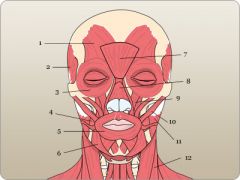
|

|
|
|
occipitalis
|
The occipitalis muscle covers the occipital region of the skull.
|
|
|
splenius capitis
|
This muscle extends from the upper three cervical vertebrae all the way to the temporal and occipital bones. It extends and rotates the head.
|
|
|
lateral pterygoid
|
This is a muscle of mastication. It originates on the pterygoid process of the sphenoid bone. It moves the mandible and limits sideways jaw movement.
|
|
|
medial pterygoid
|
Also a muscle of mastication. Both pterygoid muscles are on the inside of the mandible. The medial pterygoid elevates the jaw and provides sideways jaw movement.
|
|
|
risorius
|
The risorius originates on the side of the face and inserts on the orbicularis oris muscle. It draws the angle of the mouth laterally (to the side) and enables the human being to smile.
|
|
|
mentalis
|
The mentalis muscle originates on the chin and goes into the orbicularis oris muscle. It elevates and protrudes the lower lip. Basically it allows for pouting.
|
|
|
depressor labii inferioris
|
This muscle also originates on the mandible and inserts on to the orbicularis muscle. It depresses the bottom lip.
(Names: depressor=depress, labii=lips, inferioris=below or bottom) |
|
|
depressor anguli oris
|
This muscle originates on the lower part of the mandible. It pulls down the angle of the mouth.
(Names: depressor=depress, anguli=angle, oris=mouth) |
|
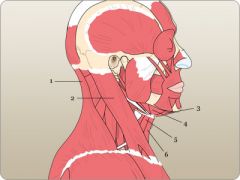
|

|
|

|
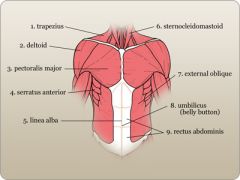
|
|
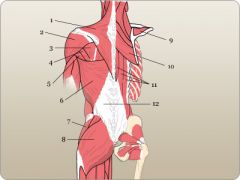
|

|
|
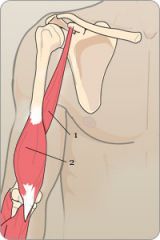
|

|
|
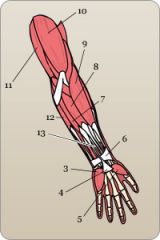
|

|
|
|
anconeus
|
Located on the back of the humerus, it extends the forearm.
|
|
|
extensor digiti minimi
|
A long narrow muscle located on the ulnar side of the extensor digitorum communis muscle. It assists in extension of the wrist and little finger.
|
|
|
extensor digitorum communis
|
Positioned in the center of the forearm along the posterior surface. Its tendon divides into four tendons beneath the extensor retinaculum, which attach to the distal tips of fingers one through four.
|
|
|
flexor digitorum profundus
|
Lies just underneath the flexor digitorum superficialis muscle. This muscle flexes the distal ends of the fingers (but not the thumb).
|
|
|
pronator teres
|
Positioned in upper middle part of the forearm. It arises from the epicondyle (a prominence or projection on a bone). It turns the hand downwards (called pronation) and flexes the elbow.
|
|
|
epicondyle
|
A prominence or projection on a bone.
|
|
|
pronator quadratus
|
Positioned deep and extends between the ulna and radius. It works with the other pronator muscle to rotate the palm of the hand down, as well as position the thumb medially.
|
|
|
supinator
|
Positioned around the upper portion of the radius. It works with the biceps to turn the palm upwards (called supination).
|
|
|
flexor pollicis longus
|
Positioned deep on the front of the radius. It attaches at the base of the thumb and flexes the thumb and makes grasping possible.
|
|

|
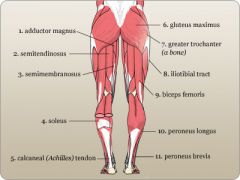
|
|
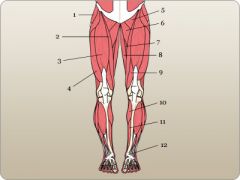
|

|
|
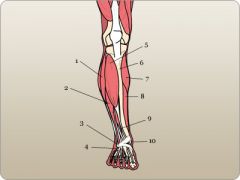
|

|
|
|
atony
|
Lack of normal tone or strength. This happens in muscles that are deprived of innervation (which is the supply of nerve fibers functionally connected with a part). Try not to confuse this term with atrophy (below) or atopy (which is a genetic predisposition towards hypersensitivity to common environmental antigens).
|
|
|
atrophy
|
The wasting away or weakening of muscle fibers due to a lack of usage. There are many different kinds of atrophy. Look up “atrophy” in a medical dictionary and read or scan the terms that appear under this category.
|
|
|
bursitis
|
Inflammation of a bursa.
|
|
|
charley horse
|
A bruised or torn muscle accompanied by cramps and severe pain. This particular injury most commonly affects the quadriceps muscle. Lay people refer to any muscle spasm of the legs or feet as a charley horse.
|
|
|
bursa
|
A sac-like cavity filled with synovial fluid and located in places where tendons or muscles pass over bony prominences.
|
|
|
cramp
|
A sustained spasm or contraction of a muscle accompanied by severe, localized pain.
|
|
|
dystonia
|
Sustained abnormal postures or disruptions of normal movement resulting from alterations of muscle tone.
|
|
|
Dupuytren contracture
|
Painless thickening and contracture of the palmar fascia due to fibrous proliferation, resulting in loss of function of the fingers.
|
|
|
fasciculations
|
Similar to fibrillations or tremors. A repetitive, involuntary contraction of muscle. The main cause is nerve damage.
|
|
|
fibromyalgia
|
A rheumatic disorder characterized by achy pain, tenderness, and stiffness.
|
|
|
myofascial pain syndrome
|
Fibromyalgia is also called myofascial pain syndrome and fibromyositis. A group of rheumatic disorders caused by achy pain, tenderness, and stiffness of muscles and tendon insertions.
|
|
|
ganglion
|
A thin-walled band cyst formed on a joint capsule or tendon sheath.
|
|
|
leiomyoma
|
A benign tumor of smooth muscle tissue (e.g., the uterus).
|
|
|
muscular dystrophy
|
A genetic abnormality of muscle tissue characterized by dysfunction and ultimately deterioration.
|
|
|
myalgia
|
Muscle pain.
|
|
|
myasthenia gravis
|
A chronic progressive neuromuscular weakness, usually starting with the muscles of the face and throat.
|
|
|
.myopathy
|
Any disease of the muscles.
|
|
|
myositis ossificans
|
A disease characterized by bony deposits or the ossification of muscle tissue.
|
|
|
paralysis
|
The loss of nervous control of a muscle. Paralysis is commonly thought of as related to paraplegia, a paralysis of the legs or quadriplegia, a paralysis of all four limbs. There are many different types of paralysis affecting many different muscles and organs of the body.
|
|
|
paraplegia
|
A paralysis of the legs (lower extremities).
|
|
|
quadriplegia
|
A paralysis of all four limbs.
|
|
|
plantar fasciitis
|
Excessive pulling or stretching of the calcaneal periosteum by the plantar fascia, resulting in pain along the inner border of the plantar fascia. This definition applies specifically to the process that affects the plantar surface of the foot. Fasciitis is inflammation of the fascia.
|
|
|
polymyositis
|
An autoimmune disorder which causes atrophy and weakness of the muscles.
|
|
|
rigor mortis
|
Rigor means chilled, stiffness, rigidity. Rigor mortis is the muscular hardness occurring 4–7 hours after death.
|
|
|
tendinitis
|
Inflammation of tendons and of tendon-muscle attachments due to trauma or repetitive wear. (Note the spelling: tendonitis is an acceptable alternative spelling, but tendinitis is preferred.).
|
|
|
tennis elbow
|
Also called lateral and medial epicondylitis. A strain of the lateral forearm muscles or the tendinous attachments near their origin on the epicondyle of the humerus. (Again note that when “tendon” is changed to another form, the “o” changes to “i”—tendinous.)
|
|
|
tetanus
|
A disease caused by the bacterium Clostridium tetani, which produces a toxin that causes muscles to go into tetany (hyperexcitability of nerves and muscles, specifically characterized by muscular cramps and twitching). Jaw muscles are affected first. Lockjaw is the more common name.
|
|
|
torticollis
|
Persistent contraction of a sternocleidomastoid muscle, drawing the head to one side and distorting the face. Causes rotation of the head.
|

